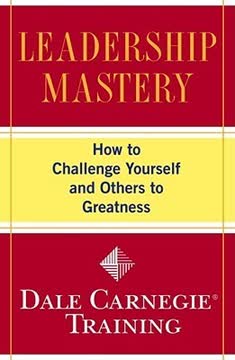Key Takeaways
1. Effective Leadership Requires Genuine Interest in Others
You can make more friends in two months by becoming interested in other people than you can in two years by trying to get other people interested in you.
Authentic engagement matters. True leadership begins with a sincere interest in others. This involves actively listening, remembering names, and showing appreciation for people's efforts and ideas. Leaders who master this skill create stronger connections, foster loyalty, and inspire their teams to perform at higher levels.
Actions speak louder than words. Effective leaders demonstrate their interest through:
- Regular one-on-one meetings with team members
- Asking thoughtful questions about people's lives and aspirations
- Recognizing and celebrating individual and team achievements
- Providing constructive feedback and opportunities for growth
By consistently showing genuine care and concern, leaders build trust and create an environment where people feel valued and motivated to contribute their best work.
2. Communication and Motivation are Cornerstones of Leadership
The ability to deal with people is as purchasable a commodity as sugar or coffee and I will pay more for that ability than for any other under the sun.
Clear communication is crucial. Leaders must be able to articulate their vision, expectations, and feedback in a way that resonates with their audience. This involves tailoring messages to different individuals and groups, using various communication channels effectively, and ensuring that information flows both up and down the organizational hierarchy.
Motivation drives performance. Great leaders understand that people are motivated by different factors and use a combination of approaches to inspire their teams:
- Providing meaningful work and connecting it to a larger purpose
- Offering opportunities for personal and professional growth
- Recognizing and rewarding good performance
- Creating a positive and supportive work environment
By mastering communication and motivation techniques, leaders can align their teams towards common goals and achieve exceptional results.
3. Inspirational Leaders Create and Pursue Compelling Visions
A leader is someone who can take a group of people to a place they themselves don't think they can go.
Vision provides direction. Inspirational leaders have the ability to see beyond the present and articulate a compelling future state. They create a vivid picture of what success looks like and communicate it in a way that resonates with others, inspiring them to join in the pursuit of that vision.
Passion fuels progress. Key characteristics of inspirational leaders include:
- Unwavering belief in their vision
- Ability to transfer importance and enthusiasm to others
- Willingness to take risks and persevere in the face of obstacles
- Charismatic communication style that energizes and motivates others
By consistently reinforcing and working towards their vision, inspirational leaders can rally their teams to achieve seemingly impossible goals and drive significant change within their organizations.
4. Organizational Leaders Focus on Structure and Efficiency
The modern organization cannot be an organization of boss and subordinate. It must be organized as a team.
Flattened hierarchies promote collaboration. Organizational leaders excel at creating streamlined, efficient structures that enable teams to work together effectively. They focus on breaking down silos, fostering cross-functional collaboration, and empowering employees at all levels to contribute their ideas and take ownership of their work.
Systems and processes drive results. Key strategies employed by organizational leaders include:
- Implementing clear decision-making processes
- Establishing measurable goals and key performance indicators
- Developing efficient workflows and communication channels
- Regularly reviewing and optimizing organizational structures
By creating a well-organized and efficient environment, these leaders enable their teams to focus on delivering results rather than navigating bureaucracy.
5. Embracing Risk and Learning from Failure Drive Success
Evolution is optimized by a maximum number of mistakes consistent with survival.
Calculated risk-taking fuels growth. Effective leaders understand that progress often requires stepping into the unknown. They encourage their teams to take smart risks, experiment with new ideas, and push beyond their comfort zones. This approach fosters innovation and helps organizations stay competitive in rapidly changing environments.
Failure is a learning opportunity. Leaders who embrace risk also cultivate a culture that views failure as a valuable learning experience:
- Encouraging open discussion of mistakes and lessons learned
- Celebrating efforts and progress, not just outcomes
- Providing support and resources for trying new approaches
- Modeling resilience and adaptability in the face of setbacks
By reframing risk and failure as essential components of growth and success, leaders create an environment where creativity and innovation can thrive.
6. Balance in Personal and Professional Life Enhances Leadership
No matter what you've done for yourself or for humanity, if you can't look back on having given love and attention to your own family, what have you really accomplished?
Holistic well-being matters. Effective leaders recognize the importance of maintaining balance in their lives. This includes taking care of their physical health, nurturing personal relationships, and pursuing interests outside of work. By doing so, they replenish their energy, gain fresh perspectives, and model healthy work-life integration for their teams.
Self-care enhances leadership capacity. Key aspects of maintaining balance include:
- Regular exercise and healthy eating habits
- Adequate sleep and stress management techniques
- Quality time with family and friends
- Engaging in hobbies and personal development activities
Leaders who prioritize balance are better equipped to handle the demands of their roles, make sound decisions, and inspire their teams to achieve sustainable success.
7. Diversity and Inclusivity are Essential in Modern Leadership
Eighty to 85 percent of the people entering the workforce in the twenty-first century will be minorities, women, or immigrants.
Diverse perspectives drive innovation. Effective leaders in today's global marketplace recognize the value of diverse teams and inclusive work environments. They actively seek out and leverage different viewpoints, experiences, and backgrounds to enhance problem-solving, creativity, and decision-making processes.
Inclusivity fosters engagement. Key strategies for promoting diversity and inclusion include:
- Implementing unbiased hiring and promotion practices
- Creating mentorship and development programs for underrepresented groups
- Fostering a culture of respect and open communication
- Regularly assessing and addressing unconscious biases
By embracing diversity and cultivating an inclusive environment, leaders can tap into the full potential of their workforce and create organizations that thrive in an increasingly interconnected world.
8. Crisis Management Tests True Leadership Mastery
If you want to avoid worry, do what Sir William Osler did. Live in day-tight compartments. Don't stew about the future, just live each day until bedtime.
Calm under pressure is crucial. True leadership mastery is often revealed during times of crisis. Effective leaders maintain composure and clarity of thought when facing challenging situations, which helps instill confidence in their teams and stakeholders.
Structured approach to crisis management. Leaders who excel in crisis situations follow a systematic approach:
- Assessing the situation calmly and gathering facts
- Breaking down complex problems into manageable components
- Identifying and prioritizing actionable steps
- Communicating clearly and regularly with all stakeholders
- Remaining flexible and adapting strategies as needed
By approaching crises with a level head and a structured methodology, leaders can guide their organizations through turbulent times and emerge stronger on the other side.
Last updated:
FAQ
What’s Leadership Mastery: How to Challenge Yourself and Others to Greatness by Dale Carnegie about?
- Core focus on leadership: The book explores the essential principles of effective leadership, emphasizing how leaders overcome obstacles and inspire greatness in themselves and others.
- Human relations in business: It highlights the growing importance of human relations skills in today’s technology-driven and rapidly changing workplace.
- Leadership for all levels: Dale Carnegie Training asserts that leadership is not just for top executives but is accessible to everyone at every level of an organization.
- Balance of styles: The book examines both inspirational and organizational leadership styles, showing how each contributes to personal and organizational success.
Why should I read Leadership Mastery by Dale Carnegie?
- Timeless, proven principles: The book distills Dale Carnegie’s classic leadership and human relations principles, updated for the modern workplace.
- Practical, actionable advice: Each chapter ends with steps readers can immediately apply to develop their leadership skills.
- Comprehensive coverage: Topics range from communication and motivation to crisis management, team building, and personal balance.
- Real-world examples: The book features success stories, such as Herb Kelleher at Southwest Airlines, to illustrate how the principles work in practice.
What are the key takeaways from Leadership Mastery by Dale Carnegie?
- Leadership is learnable: Anyone can develop leadership skills through self-assessment, practice, and mentorship.
- Balance of inspiration and organization: Both visionary and structural leadership styles are necessary for sustained success.
- Communication and motivation: Effective leaders build trust, communicate clearly, and motivate through positive reinforcement rather than fear.
- Personal well-being matters: True leadership mastery requires balancing professional responsibilities with personal health, family, and ongoing learning.
What are the main leadership styles described in Leadership Mastery by Dale Carnegie, and how do they differ?
- Inspirational leaders: These leaders energize teams with vision and charisma, creating dynamic and exciting environments but can be unpredictable.
- Organizational leaders: They focus on building stable, efficient structures and processes, ensuring consistency and long-term success.
- Complementary strengths: Both styles are essential—visionaries spark change, while organizers sustain and execute it.
- Self-awareness encouraged: The book guides readers to identify their natural style and develop strengths in both areas.
What are the core qualities and traits of effective leaders according to Leadership Mastery by Dale Carnegie?
- Optimism and resilience: Leadership masters are optimistic, cheerful, creative, and able to overcome setbacks.
- Strong communication skills: They express genuine interest in others and communicate ideas clearly and empathetically.
- Flexibility and determination: Effective leaders are confident yet adaptable, willing to take risks and persist through challenges.
- Team-building focus: They foster trust, clarify roles, and make work enjoyable for their teams.
How does Leadership Mastery by Dale Carnegie define and teach effective communication for leaders?
- Foundation of trust: Communication is built on trusting relationships and clear expectations within the broader organizational context.
- Praise and constructive criticism: Leaders start difficult conversations with sincere praise and offer criticism indirectly and empathetically.
- Active listening: Effective leaders listen carefully, encourage employee-driven solutions, and support their staff.
- Leading by example: They model positive communication and foster a respectful work environment.
What motivation strategies does Leadership Mastery by Dale Carnegie recommend for leaders?
- Positive over negative motivation: Leaders should inspire others to want to act, rather than forcing compliance through threats or punishment.
- Engage body, heart, and mind: True motivation involves action, emotion, and intelligence, requiring leaders to inspire eagerness and confidence.
- Tailor to motivational needs: Drawing on David McClelland’s theory, leaders should recognize and address different drivers—achievement, authority, and affiliation.
- Recognition and praise: Genuine appreciation and recognition are more effective motivators than financial incentives alone.
How does Leadership Mastery by Dale Carnegie approach goal-setting for leaders and teams?
- Clear, realistic goals: Leaders set well-defined, measurable, and achievable goals to provide focus and track progress.
- Short and long-term planning: Both immediate and future objectives are important, with celebrations for achievements and quick transitions to new goals.
- Transformational impact: Goal-setting can transform individuals and groups, as illustrated by real-world examples like Eugene Lang’s philanthropy.
- Continuous momentum: Leaders maintain team motivation by consistently setting and pursuing new goals.
What is Dale Carnegie’s advice on risk-taking and overcoming fear in Leadership Mastery?
- Embrace risk for growth: Leaders are encouraged to make mistakes within safe limits, viewing them as learning opportunities.
- Assess and tolerate risk: Evaluate the ratio of risk to reward and accept reasonable risks to foster growth and opportunity.
- Overcome risk aversion: Keep track of worries versus actual outcomes, seek wise counsel, and learn from failures without fear.
- Resilience through experience: Nonfatal mistakes build resilience and proactive risk-taking abilities.
How does Leadership Mastery by Dale Carnegie recommend building and maintaining effective teams?
- Value individual differences: Leaders recognize and leverage the unique skills, personalities, and perspectives of each team member.
- Avoid blame: Mistakes are addressed privately, focusing on improvement rather than finger-pointing.
- Set standards and foster pride: Teams are encouraged to set their own standards and celebrate when they meet them, building motivation and unity.
- Enrollment and unity: Leaders inspire commitment and create a sense of shared purpose, leading to self-motivated teams.
What practical tactics does Leadership Mastery by Dale Carnegie offer for decision-making, meetings, and crisis management?
- Empower through involvement: Involve employees in problem-solving and require quick responses to their solutions, boosting morale and decisiveness.
- Effective meetings: Use clear agendas, appropriate formats, and focused follow-up to ensure meetings are productive and purposeful.
- Crisis management: Stay calm, break problems into manageable parts, seek support, and avoid blame while taking full responsibility.
- Clear communication: Always state expectations and keep promises to maintain trust and clarity.
What are the best quotes from Leadership Mastery by Dale Carnegie and what do they mean?
- “Let the other person save face.” — Emphasizes the importance of preserving dignity in leadership interactions to foster respect and cooperation.
- “The final test of leaders is that they leave behind them in others the conviction and the will to carry on.” — Highlights that true leadership is about developing future leaders and sustaining the organization.
- “There is only one way under high heaven to get the best of an argument—and that is to avoid it.” — Advises that wise leaders avoid unnecessary conflict.
- “Be calm. Break the crisis down into manageable parts. See if there’s even a small part of the problem that you can solve.” — Summarizes the book’s approach to effective crisis management.
- “People may work in order to earn money, but they go the extra mile because of recognition, praise, and the intangibles.” — Underscores the power of genuine appreciation over financial incentives.
Review Summary
Leadership Mastery receives generally positive reviews for its practical leadership advice and exercises. Readers appreciate the book's focus on developing leadership skills through practice and self-reflection. Many find it valuable for both new and experienced leaders, praising its timeless principles and real-world examples. Some reviewers note that while the content may seem basic at times, it remains relevant and applicable. A few critics mention that the book lacks objective data to support its claims and may feel outdated or generic in parts.
Similar Books










Download PDF
Download EPUB
.epub digital book format is ideal for reading ebooks on phones, tablets, and e-readers.















